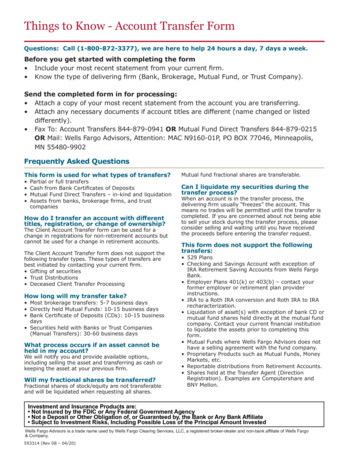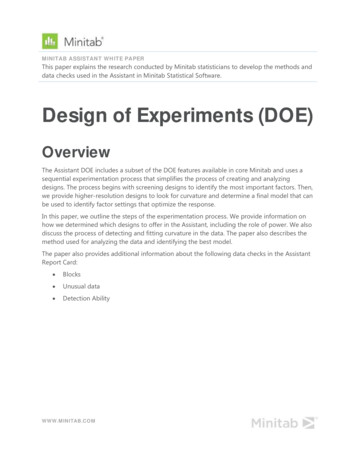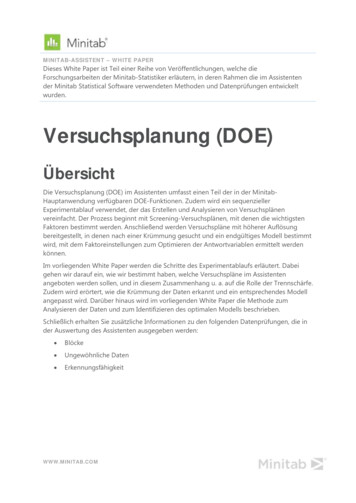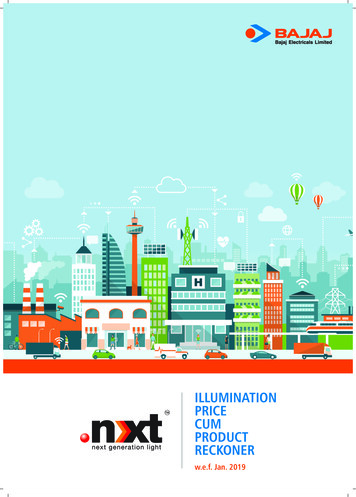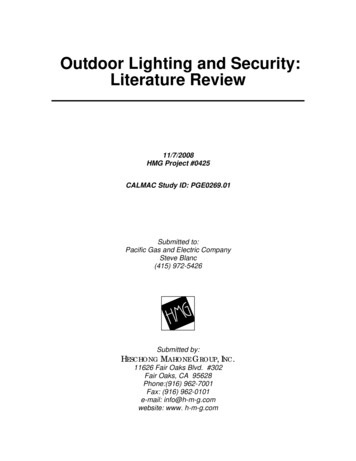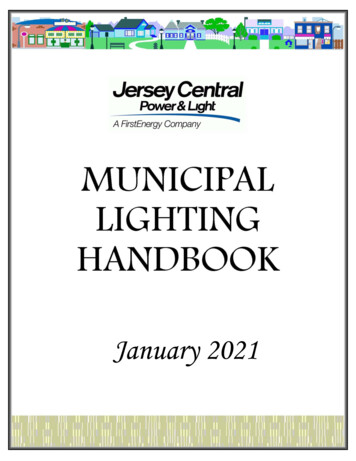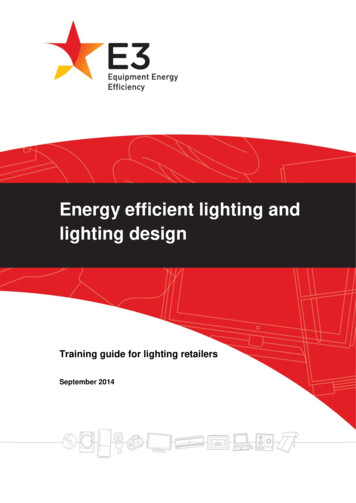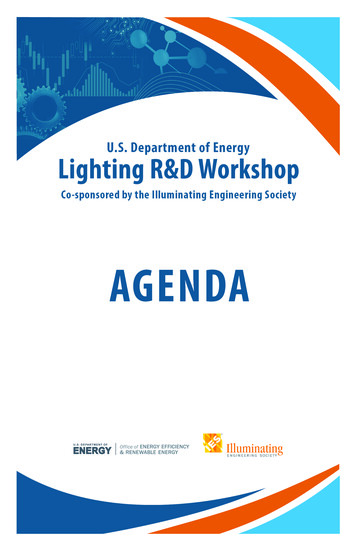
Transcription
TUESDAY JANUARY 287:00–8:00 amBreakfast8:00–8:30 amWelcomeBrian Walker, U.S. Department of EnergyBrian Liebel, Illuminating Engineering Society Diamond Room Crystal Ballroom8:30–9:15 amKeynote: Disruption Is Coming to the Building IndustryOpening remarks from a true visionary will offer a thought-provoking viewof the building industry—the technological disruption it is experiencing,what is driving the change, and what it means for Construction 2.0.Steve Burrows, Cameron MacAllister Group Crystal Ballroom9:15–10:00 amSetting the StageFor over a decade, the U.S. Department of Energy and the IlluminatingEngineering Society have partnered to advance the quality and efficiencyof lighting through science and engineering. This session will set the stagefor three days of thought-provoking discussions, with an overview ofcurrent DOE lighting R&D directions, lighting science research conductedby Pacific Northwest National Laboratory, and IES directions in researchand standards development. What research is needed to drive the nextwave of innovation? What aspects of lighting science need to be betterunderstood? What challenges must be overcome, to translate R&D toapplication? How can new frontiers in lighting leverage advances insynergistic technologies for even more energy savings?Morgan Pattison, SSLS, Inc.Kelly Gordon, Pacific Northwest National LaboratoryBrian Liebel, Illuminating Engineering SocietyBrian Walker, U.S. Department of Energy Crystal Ballroom10:00–10:30 amBreak Ballroom FoyerLIGHTING R&D WORKSHOP AGENDA PAGE 3
10:30 am–12:00 pmLighting Application EfficiencyLighting application efficiency is the next frontier in lighting energysavings. The energy savings of a lighting system is defined by the sourceefficiency and also how effectively the light is delivered into a space for acertain task. There are trade-offs between the source efficiency and colorquality, optical control, and intensity control. This panel will explore thesetrade-offs in detail, and also examine how predictive computationalmodeling of lighting application efficiency might be used as a tool toguide lighting product design, lighting layouts, and architectural design.Moderator: Morgan Pattison, SSLS, Inc.Michael Herf, f.luxWouter Soer, LumiledsSarah Safranek, Pacific Northwest National Laboratory Crystal Ballroom12:00–1:00 pmLunch1:00–2:30 pmMaterials Research &Product InnovationSee page 9for moredetailsAdvances in LEDLatest Understanding Building IntegrationDevices and Materials on PhysiologicalChallengesImpactsofLighting Room TBA Room TBA Diamond RoomLighting ScienceLighting Systems &Building Integration Room TBAAdvances in OLEDDevices and Materials Room TBA2:30–3:00 pmBreak3:00–3:30 pmOpportunities for CollaborationR&D partnerships are catalysts for innovation, as evidenced in theupcoming poster session. This panel will offer a preview of the myriadopportunities for collaboration with DOE and IES, and ask the question:What other models and methods for collaboration should be consideredto support advances and translate R&D to practice?Alex Baker, Illuminating Engineering SocietyJoel Chaddock, National Energy Technology LaboratoryRoy Harvey, Next Generation Lighting Industry Alliance Ballroom Foyer Crystal Ballroom3:30–6:00 pmPoster SessionProject posters will be presented by research team representatives,providing an opportunity for one-on-one discussions with SSL’s leadingscientists. Diamond RoomLIGHTING R&D WORKSHOP AGENDA PAGE 4
WEDNESDAY JANUARY 297:00–8:00 amBreakfast8:00–9:00 amLEDs for Photons, Physiology, and FoodLED lighting technology development and advancements in understanding physiological responses to light for plants, animals, and people havecreated the unique opportunity to save energy for all lighting, improvethe health of everyone who uses lighting, increase the productivity ofplant growth under electric lighting, and reduce the ecological impact(beyond the energy savings) of outdoor lighting. These benefits can beachieved without any fundamental, negative side effects. This panel ofdiverse experts will explore what new scientific understanding is needed—in plant, animal, and human physiological responses to light—to guidethe development and application of fully optimized lighting solutions.There is also the larger opportunity to connect and relate physiologicalresponses to light across all life forms by exploring molecular responses tolight and by comparing responses among species.Moderator/Speaker: Morgan Pattison, SSLS, Inc.George Brainard, Thomas Jefferson UniversityBruce Bugbee, University of UtahJeff Tsao, Sandia National Laboratories Diamond Room Crystal Ballroom9:00–10:00 amThe Business of LightingSome groups don’t play well together, often from a lack of understandingof what each group values. When lighting projects involve various skillsets, conflicts can arise. This panel will explore how lighting gets designedfrom both a lighting design and a design and build perspective. We willhear how products are distributed from a manufacturer’s representativeperspective, with a lighting distributor explaining their part of the process.These lighting professionals will explain what motivates them, and how abetter understanding of their roles can help us avoid conflicts.Moderator: Mark Lien, Illuminating Engineering SocietyMegan Carroll, New York DigitalErik Ennen, NALMCOBob Preston, Capital Electric/Sonepar Crystal Ballroom10:00–10:30 amBreak Ballroom FoyerLIGHTING R&D WORKSHOP AGENDA PAGE 5
10:30 am–12:00 pmMaterials Research &Product InnovationSee page 10for moredetailsLED/OLED DeviceGreat Promise,Level Light Extraction Few Options: Canand ControlAdvances in ColorScience Shift the Room TBAMarket?Lighting ScienceLighting Systems &Building IntegrationHow Do ConnectedLighting SystemsGet Specified? Room TBA Room TBA12:00–1:00 pmLunch1:00–2:30 pmMaterials Research &Product InnovationSee page11–12for moredetailsDirections in OpticalControl Diamond Room Room TBALighting ScienceSearching for HolyGrails In Search of aNew IlluminationMeasurement A Glaring Lack ofDefinition Scavenger Hunt,or Create an SPDDatabase?Lighting Systems &Building IntegrationHow Do ConnectedLighting SystemsGet Installed andConfigured? Room TBA Room TBA2:30–3:00 pmBreak3:00–4:30 pmMaterials Research &Product InnovationSee page 12for moredetailsLighting ProductInnovation Ballroom Foyer Room TBALighting ScienceConsiderations forNon-HumanPhysiologicalResponses to LightLighting Systems &Building IntegrationLighting SystemData: What Are WeLearning? Room TBA Room TBA4:30–6:00 pmOpen Discussion Forum: New Frontiers in LightingSee page 13for moredetailsOpen Discussion Forum: Translating Physiological Researchinto Practice Room TBA Room TBAOpen Discussion Forum: Clarifying the Value Proposition forConnected Lighting Systems Room TBALIGHTING R&D WORKSHOP AGENDA PAGE 6
THURSDAY JANUARY 307:00–8:00 amBreakfast8:00–8:30 amLighting Market TrendsDOE studies reveal a wealth of insights into LED adoption trends andtheir impact on energy usage. This talk will provide an overview of majortrends and changes, examining which applications are taking off andwhat technology limitations might be holding others back.Clay Elliott, Navigant Diamond Room Crystal Ballroom8:30–10:00 amNew Considerations for SSL System ReliabilityQuantifying SSL system reliability is a challenge for luminaire manufacturers due to the various components that can fail in a variety of fixturedesigns targeting application specific performance and cost thresholds.The integration of connectivity and tunability in SSL products combinedwith the use of OLEDs have resulted in new considerations for SSL reliability. This panel will explore the reliability of tunable lighting and integratedof sensors and controls. The key failures and barriers that must be overcome to certify 10-year fixture warranties will be examined.Moderator/Speaker: Monica Hansen, LED Lighting AdvisorsLynn Davis, RTI InternationalKelly Gordon, Pacific Northwest National LaboratoryBen Sweet-Block, Signify Crystal Ballroom10:00–10:30 amBreak10:30 am–12:00 pmMaterials Research &Product InnovationLighting ScienceSee page13–14for moredetailsLED Integration andManufacturingChallengesExploring Effects ofProduct Valuation onEnergy Use Room TBA Room TBA12:00–1:00 pmLunch Ballroom Foyer Diamond RoomLIGHTING R&D WORKSHOP AGENDA PAGE 7Lighting Systems &Building IntegrationConnected LightingSystem Value Room TBA
1:00–2:30 pmMaterials Research &Product InnovationSee page 14for moredetailsOLED Integrationand ManufacturingChallenges Room TBALighting ScienceTranslationalResearch inPhysiologicalResponses to LightLighting Systems &Building IntegrationLighting forGrid-InteractiveEfficient Buildings Room TBA Room TBA2:30–3:00 pmBreak3:00–4:30 pmFinal ThoughtsThis last session of the workshop will provide attendees with an opportunity to share final thoughts and observations, connecting the dotsbetween opening remarks, panel discussions, poster session conversations,and hallway chats. Have we answered the core questions we set out todiscuss? Join us for this final session, and share your thoughts. Ballroom Foyer Crystal BallroomLIGHTING R&D WORKSHOP AGENDA PAGE 8
SESSION DETAILSTUESDAY 1:00–2:30 pmn Advances in LED Devices and MaterialsMaterials and devices are the foundational “enablers” of solid-state lighting, and innovationin these would expand possibilities for the efficiency, cost, and performance of solid-statelighting engines and applications. This expert panel will discuss some of the latest innovations and new directions in light-emitting and wavelength-converting materials anddevices.Moderator: Jeff Tsao, Sandia National LaboratoriesJohn Epler, LumiledsHarald Koenig, OSRAM Opto SemiconductorsJonathan Owen, Columbia UniversityJianli Zhang, Nanchang Universityn Advances in OLED Devices and MaterialsA key challenge for OLED lighting is the development of efficient, stable devices. Thisexpert panel will review recent advancements in long-lived blue materials and explorenovel device structures and materials that aim to improve charge balance or lightoutcoupling, extending device lifetime.Moderator: Lisa Pattison, SSLS, Inc.Chris Giebink, Penn State UniversityMichele Ricks, EMD Performance MaterialsMark Thompson, University of Southern Californian Latest Understanding on Physiological Impacts of LightingThe SSL revolution has challenged our fundamental understanding of the physiologicalimpacts of light. This panel will review the latest scientific findings related to lighting forhealth and well-being and examine what is generally agreed-upon and what researchis necessary to fill gaps in understanding. The discussion will explore how the existingknowledge can be deployed into products and design standards to provide the “best”light for occupants.Moderator: Monica Hansen, LED Lighting AdvisorsTimothy Brown, University of ManchesterLuc Schlangen, Eindhoven University of TechnologyJamie Zeitzer, Stanford Universityn Building Integration ChallengesWhat role will lighting play in future buildings? This session will explore where the lightingindustry should continue investing its resources as it seeks to integrate effectively withother buildings systems.Moderator: Michael Poplawski, Pacific Northwest National LaboratoryJoel Timmins, Markon SolutionsSpeakers TBALIGHTING R&D WORKSHOP AGENDA PAGE 9
WEDNESDAY 10:30 am–12:00 pmn LED/OLED Device Level Light Extraction and ControlThe next generation of SSL devices will require high light extraction efficiency as well ashighly engineered device level optical control to maximize the amount of light hitting thetarget and minimize the requirement for luminaire-level, secondary optics. This panel willexplore state-of-the-art light extraction and control for both LED and OLED devices andcover possible paths forward, along with some fundamental understanding includingcavity effects, the Purcell effect, and plasmonic effects.Moderator: Morgan Pattison, SSLS, Inc.Michael Boroson, OLEDWorksAndrew Kim, Glint PhotonicsJongchan Kim, University of MichiganClaude Weisbuch, University of California, Santa Barbaran Great Promise, Few Options: Can Advances in Color Science Shift the Market?SSL technology introduced greater potential for spectral engineering, but whenoptimized for the same old metrics, the delivered performance has been remarkablysimilar to older light sources. With new metrics recently introduced and more researchongoing, the equation may be changing. A broader range of lighting color objectivesfacilitates optimized lighting for specific needs, from aesthetically pleasing to aidingmedical diagnoses to enhancing wellbeing, which also entails maximizing the benefitsdelivered per watt. This panel will explore discuss the range of tools available for characterizing a light source’s spectral power distribution, including those from the past (e.g.,CRI), the present (e.g.,TM-30), and future (e.g., Rt, CCT10, etc.). These tools will be relatedto changes (or lack thereof ) in the performance of architectural lighting products, andeach presenter will provide their vision for how advances in color science could, or should,change our collective thinking about lighting quality.Moderator/Speaker: Michael Royer, Pacific Northwest National LaboratoryLorne Whitehead, University of British ColumbiaTony Esposito, Lighting Research Solutionsn How Do Connected Lighting Systems Get Specified?Specifying, installing, and configuring today’s connected lighting systems is not gettingany easier. This two-part open discussion will start with a look at the specification process,asking who designs the controls, how are they specified, and who verifies the compatibilityof specified luminaires with the controls system? Perspectives from a lighting designer,manufacturer, manufacturer representative, electrical contractor, and utility programmanager will be shared as we examine their experiences in dividing up the additionalresponsibilities of connected lighting systems, and where help is needed. Part two(1:00-2:30 today) will focus on installation and configuration challenges.Moderator: Naomi Miller, Pacific Northwest National LaboratoryDan Blitzer, Practical Lighting WorkshopTeal Brogden, Horton Lees Brogden Lighting DesignMegan Carroll, New York DigitalAnthony Mulcahy, E.S.B. Electric Corp.Chris Wolgamott, Northwest Energy Efficiency AllianceLIGHTING R&D WORKSHOP AGENDA PAGE 10
WEDNESDAY 1:00–2:30 pmn Directions in Optical ControlLight whose intensity distributions could be engineered in space and time would potentially reduce the over-illumination and under-illumination of spaces—a situation that isinevitable given the current limitations of lighting technologies that are largely fixed inspace and time. This expert panel discusses new approaches to such spatially engineeredlight—both novel sources for producing, and potential applications for using, such light.Moderator: Jeff Tsao, Sandia National LaboratoriesWendy Davis, University of SydneyBilly Tubb, Theatre ConsultantSergey Vasylyev, Lucent OpticsOleg Shchekin, Lumiledsn Searching for Holy GrailsModerator: Brian Liebel, Illuminating Engineering SocietyIn Search of a New Illumination MeasurementThe traditional measurement for illumination based on the 2-degree photopic luminousefficiency function has been questioned as an accurate indicator of visual response formany years. Work supported by the DOE over the last 30 years determined that, underthe normal condition of a full field of view, relatively higher amounts of blue light contentimproved visual acuity and increased brightness perception, which would have an effecton visual efficiency, and thereby impact energy efficiency. More recent work has tied thiseffect directly to the ipRGC photoreceptor. This session brings the latest work to the forefront and asks the question: Should we modify the way we evaluate light source efficacy?Brad Schlesselman, Musco LightingA Glaring Lack of DefinitionHow do we quantify “glare,” beyond our sensation that it is painful, makes us squint orlook away, and can sometimes disable our vision? SSL lighting has been attributed asbeing too harsh or causing too much glare, but a definition for glare has eluded us forfar too long, and is necessary to understand how to design better luminaires and opticalsystems. This session will explore the most recent work being done in attempt to definemetrics beyond knowing glare when we see it.Bob Davis, Pacific Northwest National LaboratoryScavenger Hunt, or Create an SPD Database?SSL systems have the unique ability to finesse and refine spectral power distributions,which affect visual and non-visual responses to light, and these refinements cannot becaptured in the simplistic metrics of CCT and CRI (or Rf ). Understanding the effect oflight on visual or physiological outcomes of requires a detailed description of the SPDof the light, and this is becoming more important in the realms of light and health, andhorticultural lighting. This panel discusses the value proposition of creating an SPDdatabank, whereby light source SPDs can be collected and referred to by researchersand laboratories to better understand the correlations between spectral compositionand research results.Michael Herf, f.luxLIGHTING R&D WORKSHOP AGENDA PAGE 11
n How Do Connected Lighting Systems Get Installed and Configured?This session continues the morning discussion on connected lighting. In part two, we’llhear multiple perspectives on installation and configuration challenges. Who interprets thespecification? Who is responsible for proper installation, configuration, and commissioning?How do you know if it is working properly, and what happens if it doesn’t? Once again, thissession will draw on the experiences of a designer, manufacturer, manufacturer representative, electrical contractor, and utility program manager to learn how they are workingtogether to address these configuration challenges, and where help is needed.Moderator: Ruth Taylor, Pacific Northwest National LaboratoryDan Blitzer, Practical Lighting WorkshopTeal Brogden, Horton Lees Brogden Lighting DesignMegan Carroll, New York DigitalAnthony Mulcahy, E.S.B. Electric Corp.Chris Wolgamott, Northwest Energy Efficiency AllianceWEDNESDAY 3:00–4:30 pmn Lighting Product InnovationSolid-state lighting offers new levels of control over light that continue to broaden theimpact of SSL beyond just energy savings to providing a visually dynamic lighting environment for the desired application. This panel will explore how R&D advances are impactingluminaire and system designs while discussing the challenges that remain in the path ofcontinued development.Moderator: Monica Hansen, LED Lighting AdvisorsMark Hand, Acuity BrandsPaul Pickard, Ecosense LightingDan Schwade, Acuity BrandsHeinz Willebrand, Signifyn Considerations for Non-Human Physiological Responses to LightLED lighting is enabling improved productivity of plants and animals for food. This panelwill cover lighting considerations and recent research for horticultural lighting and lightingfor animal production, including latest best practices. The discussion will also cover lightingconsiderations and recent understanding for minimizing the impact of lighting on wildlifeand the environment. Panelists will cover the status of specific plant, animal, and ecologicallighting applications.Moderator: Morgan Pattison, SSLS, Inc.Bruce Bugbee, University of UtahKale Harbick, USDA Agricultural Research ServiceJeremy White, National Park Servicen Lighting System Data: What Are We Learning?What can be learned today from the data provided by lighting systems? There is plentyof talk about the potential of lighting data, but is the data actually delivering value or is itsitting in the cloud? This session looks at examples of how lighting data is delivering valuefrom optimizing building performance to improving occupant experience.Moderator: Andrea Wilkerson, Pacific Northwest National LaboratoryVladi Shunturov, Acuity BrandsAlex Cooper, Smithsonian National Portrait GallerySarah Dreger, StantecLIGHTING R&D WORKSHOP AGENDA PAGE 12
OPEN DISCUSSION FORUMS 4:30–6:00 pmNew Frontiers in LightingJoin us for a freeform discussion of SSL-synergistic technologies with significant potentialfor energy savings, including displays, agricultural lighting, germicidal irradiation, Li-Fi,high-power photonics, and power electronics. What are the energy savings opportunities?What are the key technology challenges associated with improving their energy efficiencies? How might overcoming these challenges benefit from synergies with solid-statelighting?Translating Physiological Research into PracticeWhile some lighting practitioners are attempting to apply scientific laboratory findingson physiological impact of light to field applications, the evidence base documentingphysiological responses in realistic settings has been limited. This freeform discussion willexamine the challenges in designing, installing, and evaluating lighting systems for healthand well-being. The overall objective is to identify the best practices to employ today andthe future research needs to ensure lighting is optimized for both energy efficiency andhuman response.Clarifying the Value Proposition for Connected Lighting SystemsFor five years now the lighting community has been talking about the promise of connectedlighting to finally make lighting control seamless and provide a variety of other new benefitsand features. But so far, market success has been elusive and system configuration, operation, and maintenance remain frustratingly complicated, and new value propositions hardto quantify and justify. What will it take for the true value-add of new connected lightingfeatures to be realized? Where do you find yourself on the connected lighting enthusiasmspectrum? Join the freeform discussion and bring your questions and experience—goodand not-so-good—with connected lighting systems.THURSDAY 10:30 am–12:00 pmn LED Integration and Manufacturing ChallengesThe LED lighting platform offers new opportunities for on-demand, semi-custommanufacturing which can enable reduced inventory, reduced part count, and newlighting features and capabilities.Moderator: Morgan Pattison, SSLS, Inc.Michael Bremser, Tempo LightingJohn Trublowski, EatonChikara Inamura, Designer/EngineerEugene Chow, PARCn Exploring Effects of Product Valuation on Energy UseHow much do potential buyers value new lighting features enabled by DOE research?How much might this value affect future energy use? This session will review the resultsand analysis of a recent study—which included a survey of potential lighting productbuyers—to assess how improving quality and expanding product functionality affectsproduct purchase decisions and energy use.Moderator/Speaker: Marc Ledbetter, Pacific Northwest National LaboratoryLisa Skumatz, Skumatz Economic Research AssociatesValerie Nubbe, NavigantLIGHTING R&D WORKSHOP AGENDA PAGE 13
n Connected Lighting System ValueConnected lighting systems have many purported benefits. This session will take adeep dive into a few benefits and their associated risks, along with a look at what’snext, based on what researchers and early adopters are currently exploring in thelaboratory and in the field.Moderator: Michael Poplawski, Pacific Northwest National LaboratoryFarukh Aslam, Sinclair HoldingsPeter Brown, Lighting TransitionsSpeaker TBATHURSDAY 1:00–2:30 pmn OLED Integration and Manufacturing ChallengesCost is still the major barrier to wide adoption of OLEDs in general lighting. Significantchallenges lie in both the manufacturing of OLED panels and in the integration of thepanels into lighting systems in a manner that preserves the attractive form factor ofOLEDs and allows full control of multiple panels.Moderator: Norman Bardsley, Bardsley ConsultingJoe Miller, LED SpecialistsJeff Spindler, OLEDWorksSpeaker TBAn Translational Research in Physiological Responses to LightTranslational lighting research is increasingly sought, as it incorporates the findingsindicated by basic research in laboratories with explorations with human participantsin complex, realistic settings. Translational research documents the holistic effects oflight on people and demonstrates the potential magnitude of the effects when thecomplex mix of variables that affect realistic settings are considered. This session takesa look at the latest in translational lighting research.Moderator/Speaker: Bob Davis, Pacific Northwest National LaboratoryRon Gibbons, Virginia Tech Transportation InstituteMariana Figueiro, Rensselaer Polytechnic Instituten Lighting for Grid-Interactive Efficient BuildingsLighting and grid experts are collaborating at PNNL to explore the potential forconnected lighting to provide grid services and contribute to grid-interactive efficientbuildings (GEBs). This session will present the characteristics of connected lighting thatcan support specific grid services in various building types, and the initial results ofsimulations designed to quantify this potential. We will also hear from market playerswho are exploring lighting-based grid services.Moderator: Kelly Gordon, Pacific Northwest National LaboratoryDebyani Ghosh, NavigantMonica Neukomm, U.S. Department of EnergyMichael Poplawski, Pacific Northwest National LaboratoryLIGHTING R&D WORKSHOP AGENDA PAGE 14
POSTER SESSION PRESENTERS Arizona State University Navigant Consulting Atom Inc Next Generation LightingIndustry Alliance (NGLIA) California Lighting Technology Center Columbia University North Carolina State University Lighting Technology Energy SolutionsProgram (LiTES) Ohio State University OLEDWorks LLC Eaton Corporation Pennsylvania State University Electroninks, Inc. PhosphorTech Corporation Georgia Institute of Technology Pacific Northwest NationalLaboratory (PNNL) Glint Photonics Inc. Greenhouse Lighting and SystemsEngineering (GLASE) Skumatz Economic Research Associates Illuminating Engineering Society (IES) RTI International, Inc. InnoSys Inc. Sandia National Laboratories Iowa State University South Dakota School of Minesand Technology LED Specialists Inc. LED Systems Reliability Consortium Lehigh University Lighting Enabled Systems &Applications (LESA) Lighting Research Center (LRC) Lucent Optics, Inc. Rensselaer Polytechnic Institute SSL and Energy Electronics Center(SSLEEC) University of California, Santa Barbara University of Michigan University of New Mexico University of Pittsburgh University of Southern California Lumileds, LLC Utah State University Lumisyn, LLC National Energy TechnologyLaboratory (NETL) Virginia Polytechnic Instituteand State University National Institute of Standardsand Technology (NIST) National Renewable EnergyLaboratory (NREL)LIGHTING R&D WORKSHOP AGENDA PAGE 15
Lighting application efficiency is the next frontier in lighting energy . of outdoor lighting. These benefits can be achieved without any fundamental, negative side effects. This panel of . Andrew Kim, Glint Photonics Jongchan Kim, University of Michigan Cla
